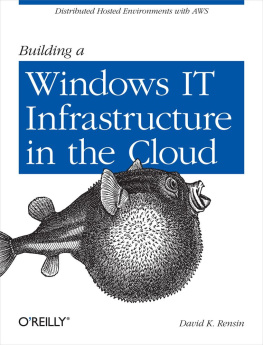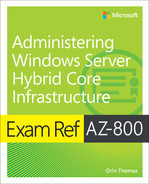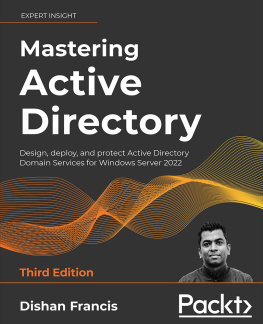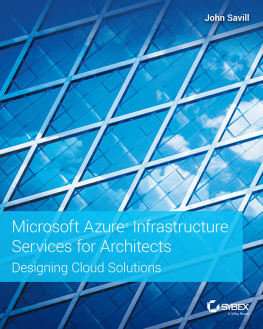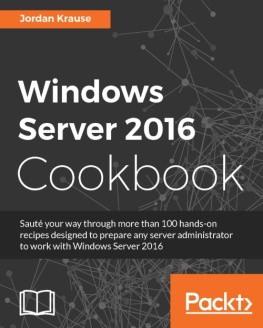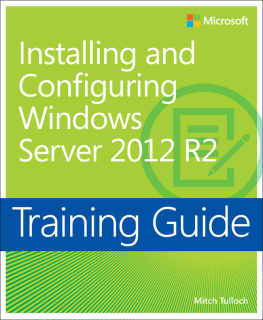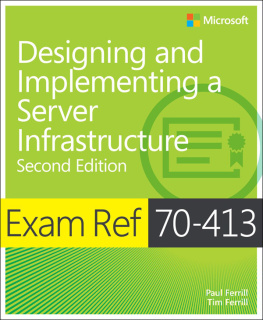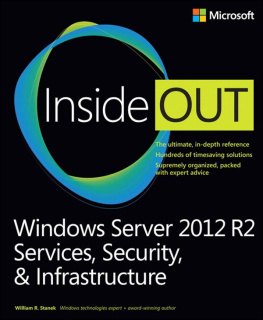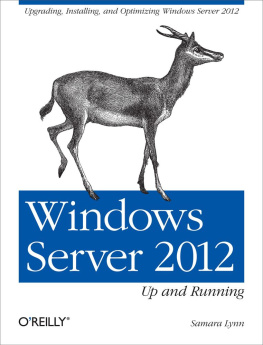Are you an IT administrator (by choice or force)? Have you ever wondered what it might be like to run your entire corporate IT infrastructure in a cloud that you controlled completely?
In this book I will walk you through how to set up a complete IT infrastructure in the AWS cloud. You dont need to have a lot of IT experience to follow alongjust a willingness to try new things and experiment a bit.
Organization of This Book
The AWS cloud offering is one of the most comprehensive ever created. It also has the advantage of being owned and operated by a company that knows a thing or two about always-on availability! Those reasons alone make it a great place for a new IT infrastructure and a very interesting topic for a book.
This book is divided into eight chapters, each one guiding you through the process of adding a critical service to your new IT cloud.
, is a basic introduction to the AWS cloud and lays the basic foundation for your new network. In it you will configure a VPN in order to securely access your growing family of resources.e
, will show you how to transform your network into a real enterprise infrastructure by creating a Windows domain.
, will guide you through the process of setting up enterprise email using Microsoft Exchange. You will also learn the basics of special DNS records called Mail Exchanger (MX) records and how to create your own managed DNS in the AWS cloud.
, will bring you up close and personal with some of the very powerful command-line tools that Amazon gives you. In particular you will learn how to take your custom-made virtual machine and import it directly into your virtual network.
, will cover the fastest growing form of enterprise communication: chat. Yes, you read that right. Chat/instant messaging is starting to take over in the enterprise, and in this chapter you will learn how to set up your own services to support it.
, will guide you through installing and configuring your very own voice-over-IP (VoIP) system so you can make and receive Internet-based telephone calls in your growing enterprise.
, will introduce you to the tools you will use to keep your new network healthy and safe. They include backup and restore, intrusion detection, and fault alerting.
, the final chapter, will take you under the hood of some of the more complicated topics covered in the previous chapters. This chapter is optional reading and is intended for people who like to take things apart just to see how they work.
Tip
A quick word about the chapter titles. Many of the titles and section headings of the chapters are bad puns. They cover the waterfront from the Old Testament to famous science fiction, heavy metal hits, and something my great-grandmother used to say in Yiddish. None of them are particularly obscure (even the one from my great-grandmother) but if you should find yourself struggling to get the reference, feel free to drop me a line at .
Conventions Used in This Book
The following typographical conventions are used in this book:
ItalicIndicates new terms, URLs, email addresses, filenames, and file extensions.
Constant widthUsed for program listings, as well as within paragraphs to refer to program elements such as variable or function names, databases, data types, environment variables, statements, and keywords.
Constant width boldShows commands or other text that should be typed literally by the user.
Constant width italicShows text that should be replaced with user-supplied values or by values determined by context.
Tip
This icon signifies a tip, suggestion, or general note.
Caution
This icon indicates a warning or caution.
Using Code Examples
This book is here to help you get your job done. In general, you may use the code in this book in your programs and documentation. You do not need to contact us for permission unless youre reproducing a significant portion of the code. For example, writing a program that uses several chunks of code from this book does not require permission. Selling or distributing a CD-ROM of examples from OReilly books does require permission. Answering a question by citing this book and quoting example code does not require permission. Incorporating a significant amount of example code from this book into your products documentation does require permission.
We appreciate, but do not require, attribution. An attribution usually includes the title, author, publisher, and ISBN. For example: Building a Windows IT Infrastructure in the Cloud by David K. Rensin (OReilly). Copyright 2012 David K. Rensin, 978-1-449-33358-4.
If you feel your use of code examples falls outside fair use or the permission given above, feel free to contact us at .
Acknowledgments
I wrote my last book in 1997. Back then I was sure that I was done writing books. When I put away my word processor for what I thought would be the last time, I had failed to meet only one of my objectives in becoming an authorto write a book for OReilly Media.
When I was in college and really starting to cut my teeth as a programmer, the OReilly catalog of books was incomprehensibly valuable to me in my learning. Titles like sed & awk , lex and yacc , Programming Perl , High Performance Computing , and others taught me much of what I still hold dear as a programmer.
They were books written by geeks for geeks and I read as many as I could get my hands on.
Back then I would never have dreamed that one day I would get the chance to contribute to that library, and I will forever be grateful to Tim OReilly for creating this one special place where all these wonderful books could get published.
I would also like to thank Mike Hendrickson, who read my proposal, liked it, and got it green-lighted by the editorial board. Hes the one who let me jump from OReilly fan to OReilly author, and for that he will forever have my thanks.
Andy Oram has been the most patient editor Ive ever worked with. Hes gone to bat for me on issues large and small, has provided unvarnished and exceptionally helpful commentary on the content, and has been an all-around good guy to work with. Thank you, Andy!
My wife Lia has long suspected my sanity. When I told her I wanted to write another book, I am certain her suspicions were immediately confirmed. The look on her face struck me as how one might look after having been slapped suddenly with a dead fish.

